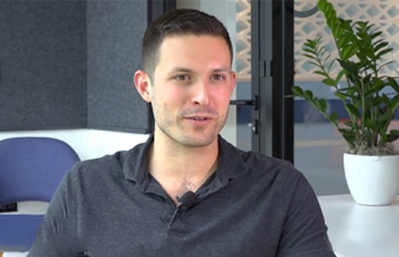- Developers
- Hiring Interview Tips
- 21 Software Engineer Technical Interview Questions and Answers for 2024

profile

By Aran Davies
Verified Expert
8 years of experience
Aran Davies is a full-stack software development engineer and tech writer with experience in Web and Mobile technologies. He is a tech nomad and has seen it all.
Create an effective job post
Your hiring manager needs to create an effective job post so that you can get appropriate candidates. Focus on the following:
Company descriptions
Describe your company factually, however, make the description effective. Talk about the growth opportunities, work environment, your company’s mission, company culture, and professional development opportunities in your organization. Explain your compensation and benefits policies.
Job descriptions for a software engineer
Your recruiter should describe the job adequately. The job description should include the type of software projects you execute. You should explain why these projects are important to you. Finally, explain why the contribution of a good software engineer as a team member is important to you.
Roles and responsibilities of a software engineer
You need a software engineer to perform the following roles and responsibilities:
- Studying the business requirements;
- Understanding the technical solutions and providing inputs to creating them;
- Collaborating with testers, DevOps engineers, etc., to establish an effective “Continuous Integration” (CI)/”Continuous Delivery” (CD) environment;
- Creating specifications for new applications;
- Coding and unit testing of new applications;
- Working with testers and DevOps engineers in testing and deployment;
- Maintaining existing applications;
- Communicating effectively with the relevant stakeholders;
- Working with the project manager, architect, and other team members to deliver sustained and tangible value to clients.
Software engineering skills and competencies to look for
You would need a software engineer with a bachelor’s degree in computer science, information technology, or related fields. Look for the following technical skills during the interview process:
- The knowledge of programming languages relevant to your project, e.g., Java, Python, JavaScript, etc., and standard web technologies;
- Familiarity with the popular development and CASE tools, e.g., web development frameworks used in your project and software analysis tools;
- Relevant experience in software development;
- Sound knowledge of software development lifecycle (SDLC) phases and models;
- Deep knowledge of popular software development methodologies like Agile, Waterfall, etc.;
- Familiarity with popular operating systems like Windows, Linux, Mac OS X, Unix, etc.;
- Knowledge of databases including SQL and NoSQL databases;
- API development experience;
- Knowledge of exception handling (when to execute multiple catch blocks, etc.);
- Understanding of user interface (UI) development frameworks and toolkits;
- Knowledge of software architecture patterns;
- Understanding of testing and DevOps processes, methods, and tools.
You don’t need software engineers with formal project management training. However, your software project manager and software developers need basic management skills. They should also be familiar with popular project management tools like Trello, Asana, etc.
You should expect a software engineer to demonstrate the following competencies:
- Problem-solving skills;
- Communication skills;
- Be passionate about excellence;
- Commitment;
- Teamwork.
Interview questions for a junior software engineer
Use the following software engineer interview questions when hiring a junior software engineer. These are basic questions, therefore, you shouldn’t expect a wrong answer to any of them.
Question 1: Explain the various types of software systems.
Answer: The various types of software systems are as follows:
- System software;
- Application software;
- Embedded software;
- Web applications;
- Artificial intelligence software;
- Scientific software.
Question 2: How does a computer program differ from computer software?
Hire expert developers for your next project
Answer: A computer program only has code. It executes predefined tasks. However, computer software includes code, documentation, and user manuals.
Question 3: Explain software re-engineering.
Answer: Software developers often need to modify the software. They might do it in various ways, and software re-engineering is one such way. Software re-engineering involves modifying software without impacting its functionality. The process of software engineering might or might not add new features to the software. However, developers use this process to improve the over experience of the software. This could include making the software more efficient and maintainable.
Question 4: What are the main phases in the software development life cycle (SDLC)
Answer: The main phases in the SDLC are as follows:
- Requirements analysis;
- Software specifications design, which includes architecture, low-level-design, etc.;
- Development phase;
- Testing phase;
- Deployment;
- Maintenance.
The “maintenance” phase might include post-deployment support, warranty support, and/or long-term maintenance.
Question 5: Name some of the popular SDLC models.
Answer: Some of the popular SDLC models are as follows:
- Waterfall;
- Iterative;
- Spiral;
- V-shaped model;
- Agile.
Question 6: Explain the “verification” and “validation” processes in software development.
Answer: “Verification” in the context of software development refers to checking whether a software system can deliver its intended function without defects. Software development teams might conduct one or more of the following verification activities:
- Inspections;
- Reviews;
- Walkthroughs.
“Validation” refers to the process of checking whether a software product meets the required quality control standards. Software development teams use the validation process to check whether they are developing the right software system. Dynamic testing falls in this category.
Neither verification process can unearth all bugs, nor can the validation processes do that. Successful software development teams use both verification and validation processes.
Question 7: Explain the role of “debugging” in the software development process
Answer: “Debugging” in the context of software development refers to finding, analyzing, and rectifying defects in software. Software engineers undertake this activity when a software system fails to meet its objectives.
This failure can manifest in many ways, e.g., a feature doesn’t work, the software system crashes, etc. The “debugging” process can be simple or complex depending on the nature of the defects.
A software development team might need to analyze the root cause of the defect, fix the code, and test it. “Debugging” ends when you successfully implemented the tested fix and the software works as expected.
Question 8: List a few programming languages suitable for writing algorithms.
Answer: The following programming languages are good for writing algorithms:
- Python;
- Ruby;
- C;
- Java;
- C#;
- C++.
Question 9: How do you find the size of a software product?
Answer: There are two ways to measure and express the size of a software product, and these are as follows:
- “Lines of code” (LOC): This involves counting the total lines of code in a software system. Software engineers use this option to find the size of a legacy software system.
- “Function points” (FP): A function point is a unit to measure the amount of functionality delivered in a software product. Software engineers can use several recognized standards like COSMIC, FiSMA, etc., to measure the size of software based on FPs.
Question 10: What is “Software Configuration Management”?
Hire expert developers for your next project
1,200 top developers
us since 2016
Answer: “Software Configuration Management” (SCM) is a process to manage changes to documents, code, and other entities during the SDLC. The SCM process involves organizing the changes to the documents and code. This process enables a software engineer to effectively control these changes, which reduces errors.
The tasks in the SCM process are as follows:
- Identifying configurable items;
- Establishing baselines;
- Implementing change control processes;
- Configuration status reporting;
- Conducting configuration audits.
Software engineer interview questions for a mid-level software developer
The following software engineer interview questions will help you in interviewing or re-interviewing a mid-level software engineer:
Question 11: Explain the importance of the “Agile” methodology in software development.
Answer: Traditionally, many software development projects used the “Waterfall” methodology. This methodology prescribes the completion of a phase like requirements analysis or specifications design before proceeding to the next phase. E.g., a software development team should finalize the software scope and requirements before starting the specifications design phase.
The development team undergoes detailed reviews after each phase. It obtains sign-off from the relevant stakeholders before proceeding to the next phase.
While the “Waterfall” methodology is structured, it can sometimes be hard to use. Technology is evolving rapidly. New possibilities are emerging, and requirements keep changing. Working with a fixed set of requirements can often be unrealistic. The “Agile” methodology offers a solution to this.
Agile software development teams work very closely with end-users. The methodology uses an iterative approach, where the requirements can change. The technical solutions change according to the requirements. Close collaboration between the business stakeholders and the development team helps to work in this fluid environment.
Question 12: How do functional requirements differ from non-functional requirements (NFRs)?
Answer: Functional requirements describe what a software system should do. These describe the output that users can expect based on a specific input. Functional requirements describe the features to offer, e.g., reports, interactive features, etc.
Non-function requirements (NFRs) concern themselves with how well a software system performs. These requirements include performance, scalability, reliability, availability, security, maintainability, etc. A software system must meet both functional and non-functional requirements to deliver sustained value.
Question 13: What does a runtime environment do?
Answer: We expect a computer program to run on all popular operating systems. We expect that for all programming languages. However, operating systems vary significantly from each other. Programs might require modifications for them to run on a particular operating system (OS). This would make software development tedious and complex. A “runtime environment” solves this challenge.
A runtime environment (RTE) works as a small OS. It provides all the functionalities for a program written in a particular language to run. Towards this, an RTE includes interfaces to the hardware, user interactions, and software components. This enables it to load an application and run it on an OS. Developers don’t need to modify programs to work with an OS.
A few popular runtime environments are as follows:
- JRE (Java Runtime Environment);
- Node.js: The popular runtime environment for JavaScript;
- .NET framework: This helps to run Windows .NET applications.
Question 14: Explain the importance of metrics in software development with examples.
Answer: Metrics in software development are quantitative measurements to gauge the health of the project. A software development team should specify the metrics that it should measure. It should measure project execution metrics that are relevant to the project type.
The team should set goals that match the industry standards, and the team should effectively monitor these metrics. The project manager should act appropriately if the team deviates from the goals.
The following are a few examples of software metrics:
- Code metrics: lines of code (LOC);
- Developer productivity metrics: Active days, and efficiency;
- Agile process metrics: Lead time, cycle time, and velocity;
- Test metrics: Code coverage, defects in production, and the percentage of automated tests.
Question 15: Explain the concept of concurrency in software applications.
Answer: In the context of software applications, concurrency is an attribute that allows multiple events or actions to take place simultaneously. Some software systems allow two or more processes to execute simultaneously. We call them concurrent processes.
Hire expert developers for your next project
Programming languages like Java and Scala support concurrency natively. These languages support threads and synchronization. On the other hand, languages like C and C++ support concurrency with the help of external libraries.
Question 16: Explain the differences between black-box testing and white-box testing.
Answer: Black-box testing validates if a program produces the desired output based on the input data. This kind of testing doesn’t look into how the program has implemented functionality. White-box testing checks for the expected output based on the input. Additionally, this kind of testing also verifies whether a program has implemented the code correctly.
Software engineering interview questions for senior programmers
When interviewing senior software engineers, you might need to use the “whiteboard coding” practice. It requires the candidate to write either the pseudocode or the code to solve a problem. Additionally, use the following technical software engineer interview questions while interviewing a senior software engineer:
Question 17: Explain the advantages of creating an API during software development.
Answer: Creating an API offers the following advantages:
- An organization might have valuable data. Creating an API in the backend allows the front end of the application to access the data in an efficient manner. Modifying the data doesn’t require a modification of the front-end program.
- APIs allow developers to decouple the front end from the back end of the application. A software development team can develop them in parallel.
- Using APIs helps software developers integrate new sources of data into the application. They don’t need to change the front end of the application when integrating new data sources.
- Using APIs allows flexibility since APIs make the delivery of services and information easier.
Question 18: What are the advantages of object-oriented programming (OOP)?
Answer: Object-oriented programming (OOP) offers the following advantages:
- Modularity: Objects are self-contained, which provides modularity. This makes debugging easier.
- Reusing pieces of code: OOP allows inheritance between classes. This makes it easier to reuse code.
- Flexibility: In OOP, one function can shape-lift to adapt to the class it’s in. This allows flexibility.
- The ease of problem-solving: OOP allows you to break your application down into components. You will find it easier to solve problems concerning individual components than the entire application.
Question 19: Explain the operations of a “stack”.
Answer: “Stacks” are linear data structures. These data structures use a “Last in, first out” structure. This enables operations that remove the latest elements added to the stack as the first element for removal. Software developers use stacks for the following 3 operations:
- “Push”: This refers to inserting an element into the stack from the top.
- “Pop”: This involves the removal of the latest element added to a stack.
- “Peek”: With this kind of operation, you can see an element within a stack without modifying it.
Question 20: Explain the decomposition technique for estimating a software development project.
Answer: The decomposition technique to estimate a software development project breaks a project down into major functions or software engineering activities. A software engineer utilizing this technique then estimates each function or activity. The steps for each function are as follows:
- Understand the scope of that function;
- Create an estimate for the software size based on the function;
- Produce an estimate for the effort and cost based on the software engineering activities;
- Reconcile the estimates by studying the variances between the two above-mentioned estimates.
Question 21: Explain the differences between function-oriented design and object-oriented design.
Answer: A software system designed using the function-oriented approach has many smaller subsystems. We call these sub-systems “functions”. Each of these functions can perform significant tasks.
On the other hand, object-oriented design revolves around objects (entities). Object-oriented design works around classes (categories) and methods (functions) of these objects.
Summary
You can print this software engineer interview questions and answers sheet for ease of use in the hiring process. Please contact us at DevTeam.Space if you need help hiring managers and smart software engineers.



